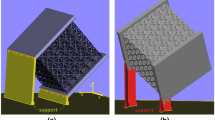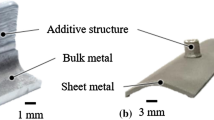Abstract
Design for additive manufacturing (DfAM) enables the design and fabrication of intricate but application-based functionally optimized geometries by reducing the manufacturing time. It also gave unlimited design freedom to alter any specific parameter and regenerate the design with improved mechanical properties. However, designing a complex and application-specific component needs comprehensive knowledge of drawing, intended usage, high expertise, and command of designing software with ample time. Mechanical springs, e.g., wave springs of uniform/complex shaped designs, consume a significant amount of manual hard work. A new design tool, WSdesign, is developed for constructing wave springs of different morphologies with uniform or varying design parameters or a combination of both. A graphical user interface (GUI) was developed in which the user can select the type of wave spring, which can be either uniform, functional gradient, or hybrid with parametric variation defined through Python code. The code is directly run in Autodesk Fusion 360 software which is used to transform that code into a 3D model with all defined features and can be saved in different formats or can be directly printed. Two designs, i.e., rectangular and variable thickness wave springs, were designed each using WSdesign and SolidWorks (manual method), manufactured, and analyzed by performing uniaxial compression testing. The results were compared with each other which were further validated by finite element analysis and found that both design strategies have negligible variations. Furthermore, several designs of complex-shaped wave springs were successfully designed and manufactured using fused deposition modeling (FDM), stereolithography (SLA), and powder bed fusion (MJF) technology with different materials, resulting in a good surface finish, smooth printability, and less dimensional variation, which proves the versatility of WSdesign. In addition, this methodology also enables to design of application-based wave springs for research and industrial usage as per load requirements without having in-depth design expertise and spending much less time.














Similar content being viewed by others
Availability of data and materials
Data is available on request from the authors.
References
Burton HE, Eisenstein NM, Lawless BM, Jamshidi P, Segarra MA, Addison O, Shepherd DET, Attallah MM, Grover LM, Cox SC (2019) The design of additively manufactured lattices to increase the functionality of medical implants. Mater Sci Eng C 94:901–908. https://doi.org/10.1016/J.MSEC.2018.10.052
Zhang XZ, Leary M, Tang HP, Song T, Qian M (2018) Selective electron beam manufactured Ti-6Al-4V lattice structures for orthopedic implant applications: current status and outstanding challenges. Curr Opin Solid State Mater Sci 22:75–99. https://doi.org/10.1016/J.COSSMS.2018.05.002
Najmon JC, Raeisi S, Tovar A (2019) Review of additive manufacturing technologies and applications in the aerospace industry. Addit Manuf Aerosp Ind 7–31. https://doi.org/10.1016/B978-0-12-814062-8.00002-9
Helou M, Kara S (2017) Design, analysis and manufacturing of lattice structures: an overview 31:243–261. https://doi.org/10.1080/0951192X.2017.1407456
Chougrani L, Pernot JP, Véron P, Abed S (2019) Parts internal structure definition using non-uniform patterned lattice optimization for mass reduction in additive manufacturing. Eng Comput 35:277–289. https://doi.org/10.1007/S00366-018-0598-2/FIGURES/14
Friedrich H, Schumann S (2001) Research for a “new age of magnesium” in the automotive industry. J Mater Process Technol 117:276–281. https://doi.org/10.1016/S0924-0136(01)00780-4
Nagesha BK, Dhinakaran V, Shree MV, Kumar KM, Chalawadi D, Sathish T (2020) Review on characterization and impacts of the lattice structure in additive manufacturing. Mater Today Proc 21:916–919. https://doi.org/10.1016/J.MATPR.2019.08.158
Yu S, Sun J, Bai J (2019) Investigation of functionally graded TPMS structures fabricated by additive manufacturing. Mater Des 182:108021. https://doi.org/10.1016/J.MATDES.2019.108021
Babamiri BB, Askari H, Hazeli K (2020) Deformation mechanisms and post-yielding behavior of additively manufactured lattice structures. Mater Des 188:108443. https://doi.org/10.1016/J.MATDES.2019.108443
Köhnen P, Haase C, Bültmann J, Ziegler S, Schleifenbaum JH, Bleck W (2018) Mechanical properties and deformation behavior of additively manufactured lattice structures of stainless steel. Mater Des 145:205–217. https://doi.org/10.1016/J.MATDES.2018.02.062
Al-Ketan O, Rowshan R, Al-Rub RK (2018) Topology-mechanical property relationship of 3D printed strut, skeletal, and sheet based periodic metallic cellular materials. Addit Manuf 19:167–183. https://doi.org/10.1016/J.ADDMA.2017.12.006
Daynes S, Feih S, Lu WF, Wei J (2019) Design concepts for generating optimised lattice structures aligned with strain trajectories. Comput Methods Appl Mech Eng 354:689–705. https://doi.org/10.1016/J.CMA.2019.05.053
Wu J, Wang W, Gao X (2021) Design and optimization of conforming lattice structures. IEEE Trans Vis Comput Graph 27:43–56. https://doi.org/10.1109/TVCG.2019.2938946
SOLIDWORKS. https://www.solidworks.com/
Fusion 360 with Netfabb Get Prices & Buy Netfabb | Autodesk. https://www.autodesk.com/products/netfabb/overview
MATLAB - MathWorks - MATLAB & Simulink. https://www.mathworks.com/products/matlab.html?s_tid=hp_ff_p_matlab
Maskery I, Sturm L, Aremu AO, Panesar A, Williams CB, Tuck CJ, Wildman RD, Ashcroft IA, Hague RJM (2018) Insights into the mechanical properties of several triply periodic minimal surface lattice structures made by polymer additive manufacturing. Polymer (Guildf) 152:62–71. https://doi.org/10.1016/J.POLYMER.2017.11.049
Dong Z, Zhao X (2021) Application of TPMS structure in bone regeneration. Eng Regen 2:154–162. https://doi.org/10.1016/J.ENGREG.2021.09.004
Qureshi ZA, Al-Omari SAB, Elnajjar E, Al-Ketan O, Al-Rub RA (2021) Using triply periodic minimal surfaces (TPMS)-based metal foams structures as skeleton for metal-foam-PCM composites for thermal energy storage and energy management applications. Int Commun Heat Mass Transf 124:105265. https://doi.org/10.1016/J.ICHEATMASSTRANSFER.2021.105265
Catchpole-Smith S, Sélo RRJ, Davis AW, Ashcroft IA, Tuck CJ, Clare A (2019) Thermal conductivity of TPMS lattice structures manufactured via laser powder bed fusion. Addit Manuf 30:100846. https://doi.org/10.1016/J.ADDMA.2019.100846
Al‐Ketan O, Abu Al‐Rub RK (2021) MSLattice: a free software for generating uniform and graded lattices based on triply periodic minimal surfaces. Mater Des Process Commun 3:e205. https://doi.org/10.1002/MDP2.205
Sigmund O (2001) A 99 line topology optimization code written in Matlab. Struct Multidiscip Optim 212.21(2014):120–127. https://doi.org/10.1007/S001580050176
Zhong RY, Xu X, Klotz E, Newman ST (2017) Intelligent manufacturing in the context of industry 4.0: a review. Engineering 3:616–630. https://doi.org/10.1016/J.ENG.2017.05.015
McFarlane D, Sarma S, Chirn JL, Wong CY, Ashton K (2003) Auto ID systems and intelligent manufacturing control. Eng Appl Artif Intell 16:365–376. https://doi.org/10.1016/S0952-1976(03)00077-0
Gibson I, Rosen D, Stucker B, Khorasani M (2021) Software for additive manufacturing. Addit Manuf Technol 491–524. https://doi.org/10.1007/978-3-030-56127-7_17
Jared BH, Aguilo MA, Beghini LL, Boyce BL, Clark BW, Cook A, Kaehr BJ, Robbins J (2017) Additive manufacturing: toward holistic design. Scr Mater 135:141–147. https://doi.org/10.1016/J.SCRIPTAMAT.2017.02.029
Gleadall A (2021) FullControl GCode Designer: open-source software for unconstrained design in additive manufacturing. Addit Manuf 46:102109. https://doi.org/10.1016/J.ADDMA.2021.102109
Rajaguru K, Karthikeyan T, Vijayan V (2020) Additive manufacturing – state of art. Mater Today Proc 21:628–633. https://doi.org/10.1016/J.MATPR.2019.06.728
Blakey-Milner B, Gradl P, Snedden G, Brooks M, Pitot J, Lopez E, Leary M, Berto F, du Plessis A (2021) Metal additive manufacturing in aerospace: a review. Mater Des 209:110008. https://doi.org/10.1016/J.MATDES.2021.110008
Kumar MB, Sathiya P (2021) Methods and materials for additive manufacturing: a critical review on advancements and challenges. Thin-Walled Struct 159:107228. https://doi.org/10.1016/J.TWS.2020.107228
Wave spring vs. coil spring | Smalley. https://www.smalley.com/blog/wave-spring-vs-coil-spring
Top 6 reasons to use a wave spring. https://www.designworldonline.com/top-6-reasons-to-use-a-wave-spring/
Scheuer C, Boot E, Carse N, Clardy A, Gallagher J, Heck S, Marron S, Martinez-Alvarez L, Masarykova D, McMillan P, Murphy F, Steel R, Van Ekdom H, Vecchione H (2021) Disentangling inclusion in physical education lessons: developing a resource toolkit for teachers. pp 343–354. https://www.research.ed.ac.uk/en/publications/disentangling-inclusion-in-physical-education-lessons-developing-
US9039766B1 - Wave spring for a spinal implant - Google Patents. https://patents.google.com/patent/US9039766?oq=wave+spring
ul Haq MR, Nazir A, Jeng JY (2021) Design for additive manufacturing of variable dimension wave springs analyzed using experimental and finite element methods. Addit Manuf 44:102032. https://doi.org/10.1016/J.ADDMA.2021.102032
ulHaq MR, Nazir A, Lin SC, Jeng JY (2021) Parametric investigation of functionally gradient wave springs designed for additive manufacturing. Int J Adv Manuf Technol 1–19. https://doi.org/10.1007/S00170-021-08325-3/FIGURES/22
ulHaq MR, Nazir A, Lin SC, Jeng JY (2022) Investigating the effect of design parameters on the mechanical performance of contact wave springs designed for additive manufacturing. https://Home.Liebertpub.Com/3dp. https://doi.org/10.1089/3DP.2021.0313
Welcome to Python.org. https://www.python.org/
Fusion 360 3D CAD, CAM, CAE & PCB Cloud-Based Software Autodesk. https://www.autodesk.com/products/fusion-360/overview
Visual Studio Code - Code Editing. Redefined. https://code.visualstudio.com/
SOLIDWORKS. https://www.solidworks.com/ (accessed 2 Nov 2021)
BinArshad A, Nazir A, Jeng JY (2022) Design and performance evaluation of multi-helical springs fabricated by multi jet fusion additive manufacturing technology. Int J Adv Manuf Technol 118:195–206. https://doi.org/10.1007/S00170-021-07756-2/FIGURES/13
HP 3D Jet Fusion 4200 - Commercial & Industrial 3D Printer HP Official Site. https://www.hp.com/us-en/printers/3d-printers/products/multi-jet-fusion-4200.html (accessed 11 Nov 2021)
Cai C, Tey WS, Chen J, Zhu W, Liu X, Liu T, Zhao L, Zhou K (2021) Comparative study on 3D printing of polyamide 12 by selective laser sintering and multi jet fusion. J Mater Process Technol 288:116882. https://doi.org/10.1016/J.JMATPROTEC.2020.116882
Designation: F2792 − 12a. https://doi.org/10.1520/F2792-12A
Bartolo PJ. Stereolithography materials, processes and applications. Springer
HP Multi Jet Fusion 3D Printing Technology - Powder 3D Printer HP Official Site. https://www.hp.com/us-en/printers/3d-printers/products/multi-jet-technology.html
O’Connor HJ, Dickson AN, Dowling DP (2018) Evaluation of the mechanical performance of polymer parts fabricated using a production scale multi-jet fusion printing process. Addit Manuf 22:381–387. https://doi.org/10.1016/j.addma.2018.05.035
Habib FN, Iovenitti P, Masood SH, Nikzad M (2018) Fabrication of polymeric lattice structures for optimum energy absorption using multi jet fusion technology. Mater Des 155:86–98. https://doi.org/10.1016/j.matdes.2018.05.059
Fatigue behaviors of different materials for schanz screws in femoral fracture model using finite element analysis | Request PDF. https://www.researchgate.net/publication/274720498_Fatigue_behaviors_of_different_materials_for_schanz_screws_in_femoral_fracture_model_using_finite_element_analysis
Bai J, Song J, Wei J (2019) Tribological and mechanical properties of MoS2 enhanced polyamide 12 for selective laser sintering. J Mater Process Technol 264:382–388. https://doi.org/10.1016/j.jmatprotec.2018.09.026
Wave spring Technology – SPIRA INC. https://spira.com/pages/wavespring-technology
US9039766B1 - Wave spring for a spinal implant - Google Patents. https://patents.google.com/patent/US9039766B1/en
Funding
This work was financially supported by the High-Speed 3D Printing Research Center (grant no. 108P012) from the Featured Areas Research Center Program within the framework of the Higher Education Sprout Project by the Ministry of Education (MOE) Taiwan.
Author information
Authors and Affiliations
Corresponding author
Ethics declarations
Ethics approval
Not applicable.
Consent to participate
Not applicable.
Consent for publication
Not applicable.
Conflict of interest
The authors declare no competing interests.
Additional information
Publisher's Note
Springer Nature remains neutral with regard to jurisdictional claims in published maps and institutional affiliations.
Supplementary Information
Below is the link to the electronic supplementary material.
Rights and permissions
Springer Nature or its licensor holds exclusive rights to this article under a publishing agreement with the author(s) or other rightsholder(s); author self-archiving of the accepted manuscript version of this article is solely governed by the terms of such publishing agreement and applicable law.
About this article
Cite this article
Haq, M.R.u., Nazir, A., Azam, H. et al. WSdesign: a mathematical design method for generating uniform and functionally gradient/hybrid wave springs, fabricated using additive manufacturing processes. Int J Adv Manuf Technol 121, 7763–7778 (2022). https://doi.org/10.1007/s00170-022-09818-5
Received:
Accepted:
Published:
Issue Date:
DOI: https://doi.org/10.1007/s00170-022-09818-5




